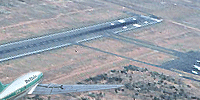 |
 |
|
||||
|
By
Wikipedia,
The Douglas DC-5, the least known of the famous DC airliner series, was a 16-22 seat, twin-propeller aircraft intended for shorter routes than the DC-3 or DC-4. However, by the time it entered commercial service in 1940, many airlines were canceling orders; consequently, only five civilian DC-5s were ever built. With the Douglas Aircraft Company already converting to war production, the DC-5 was soon overtaken by events, although a limited number of military variants were produced. Design and developmentThe Douglas DC-5 was developed as a 16/22 passenger civilian airliner, with a high wing and innovative tricycle landing gear (unique for the time). One prototype and four production aircraft were constructed prior to World War II. Operational serviceIronically, the prototype (configured with just eight seats) became the personal aircraft of William E. Boeing; since his own company was already in full military production mode. It was later impressed into the Navy and converted for military use as an R3D variant. The other four planes were sold to KLM and used by their colonial subsidiaries. They were used to evacuate civilians from Java to Australia in 1942. One aircraft, ex-PK-ADA was captured by the Japanese and operated as a transport, in camouflage with Japanese markings. Two of them later operated in Australia and, in 1948, the last surviving DC-5 (c/n 426) was smuggled to Israel for military use. The aircraft arrived at Haifa in May 1948, and from there went to Sde Dov, where its former markings were removed and the name "Yankee Pasha - The Bagel Lancer" crudely painted on the nose by hand. The aircraft joined the 103rd transport squadron at Ramat David, but as Israel was in the midst of the 1948 Arab-Israeli War, was occasionaly used as a bomber as well. This was achieved by removing the aft door and pitching the bombs out of the opening. When the war ended and the 103rd squadron moved, the DC-5 was left behind. It eventually found its way to the Israeli Air Force's Technical School in Haifa Airport, but was scrapped some time after 1955. Variants
OperatorsMilitary operators
Civil operators
Specifications (DC-5)General characteristics
Performance
See alsoRelated lists
External links
Text from Wikipedia is available under the Creative Commons Attribution/Share-Alike License; additional terms may apply.
Published in July 2009. Click here to read more articles related to aviation and space!
|
||||||||||||||||||||||||||||||||||||||||||||||||||||||

 |
|
Copyright 2004-2025 © by Airports-Worldwide.com, Vyshenskoho st. 36, Lviv 79010, Ukraine Legal Disclaimer |